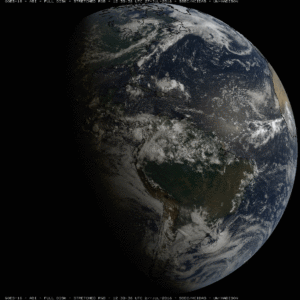
GOES-16 image from 27 July 2018 that shows the terminator and the tilt of the Earth (1 month after the summer solstice).
The welcome respite we just enjoyed from the prolonged heat and humidity of late June and July may have inspired fond thoughts of autumn to many in southern Wisconsin.
Of course, there is still a lot of summer left, though we have just passed the climatologically warmest day of the year in Madison – July 14/15. This closely coincides with the date on which air with a temperature of 23 degrees at about 1 km above the surface shrinks to its annual minimum extent.
In some years, such cold air completely disappears over the entire Northern Hemisphere. In the past five years, for instance, the cold air has completely disappeared for a short period of time in 2013 (July 16), 2015 (July 17-19) and 2016 (July 23) while tiny puddles of such cold air hung on during both 2014 and 2017.
It appears that this year (thus far) the 23-degree air will hold on as it did last year, barely, with its smallest areal extent having occurred unusually early (June 30).
In recent research concerning global warming, we have tracked the areal extent of such air for the last 70 winters (December, January, February), finding that the wintertime coldpool has systematically shrunk since at least 1948. By late January, the coldest point in the Northern Hemisphere winter, its areal extent grows to about 25 million square miles.
So, as you rejoice at our recent relief from the summer’s heat and humidity, be aware that the enormous reservoir of cold air that will occupy the Northern Hemisphere this winter is just beginning to grow and nothing can stop it from spreading.

